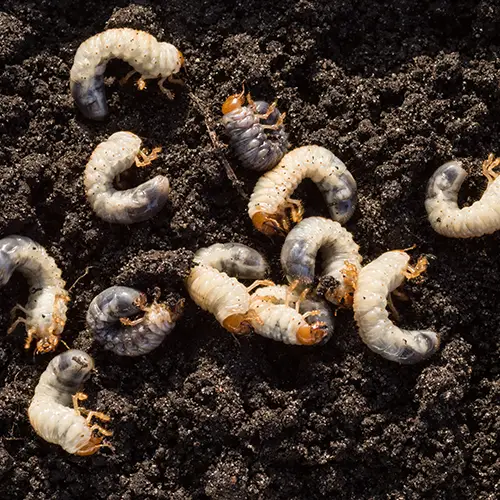
Most of the time worms are harmless and even beneficial for our yards but this is not always the case. Some worm species can destroy our carefully cultivated gardens, shrubs, and decorative grasses. The good news is that the threat of some species of worms to our properties can be dealt with by the professionals at Live Oak Pest Control.
There are eight varieties of worm species that we deal with on a regular basis. They are the; Bagworms, Oleander Caterpillars, Fall Web Worm, Grub Worms, Eastern Tent Caterpillar, Fall Armyworm, Tropical Sod Web Worm, and the Azalea Caterpillar. There are more types of worms that can invade your yard and wreak havoc, but these are the types we will cover briefly in this article.
Bagworms: You will generally see Bagworms hanging on the walls (inside the home) and also in trees in Florida. Bagworms are larvae and are rarely seen outside their bag. Full grown bagworms are a dull gray color with darker markings towards the head.
Oleander Caterpillars: The Oleander Caterpillar is a bright orange caterpillar with long black hairs. It is common to find them on Oleanders in Florida and southern Georgia. The adult moth stage is often called the “polka-dot wasp moth” because of their resemblance to wasps. The moth body and wings are very colorful; iridescent blue/green with small white dots.
Fall Web Worm: The Adult Fall Web Worm moth is all white and appears fuzzy. Here in Florida, the adult moth can have dark brown spots and their front legs are orange or bright yellow. Adult moths have a wingspan of 1.4 – 1.7 inches. Adult moths are seen from May to August while they lay their eggs. The Fall Web Worm head can either be black or red; the black-headed larvae are thought to be prevalent in northern climates while red-headed larvae are thought to be dominant in the south.
Grub Worms: Grubworms are “C”-shaped and have a brown head and a cream colored body. When they are found in the soil they are normally always found in the “C” shape. Adult grubworm beetles are better known as June Beetles and are about a half inch long and brown in color.
Eastern Tent Caterpillar: These worms get their name from the silken tent-like structure that they live in. They will come out of their shelter each day and feed on nearby leaves only leaving the midrib. Adult moths are reddish brown with white stripes.
Fall Armyworm: The Fall Armyworm caterpillar is either green or brown and are 1.5 inches long. As the armyworm grows it develops light stripes horizontally and dark spots on the top of each segment. Easily identify a Fall Armyworm by the light colored “Y” on their head.
Tropical Sod Web Worm: Tropical Sod Web Worms are a grayish-green color and have brown spots on each segment. Mature larvae of Tropical Sod Web Worms are 3/4 to 1 inch long and they pupate (leave the cocoon as from a young pupae) in the grass thatch or soil surface. The Tropical Sod Web Worm caterpillar is a translucent green with small dark spots on each segment and has a yellowish-brown head.
Azalea Caterpillar: Azalea Caterpillars are found in North Central Florida primarily from July to October on Azaleas. The adult Azalea Caterpillar is about 2 inches long, predominately black with yellow horizontal stripes and the head & legs are a mahogany-red. If the Azalea Caterpillar is disturbed they will often raise its front and rear ends into the air.
If you are experiencing a Worm or Caterpillar problem give us a call today at (386) 362-3887 to let a Lawn Care Specialist treat and eliminate them from your lawn.
Worm Pests In Florida Serving McAlpin, FL
Highway 129, Highway 249
Lake City | Live Oak | Perry | Chiefland | High Springs
Jonesville | Newberry | Trenton | Bell | Branford
Home » Worm Pests In Florida
